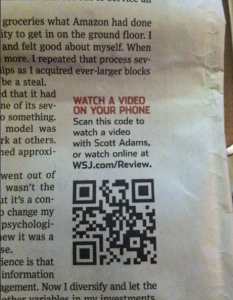The Wall Street Journal and QR Codes in Print Publications
Posted on by Timothy Boyle I was reading the Wall Street Journal a week or so ago and began reading an article by one of my favorite cartoonists Scott Adams, author of “Dilbert,” titled No, Please Don’t Follow Your Passion. It was a great article about why you shouldn’t follow your passions and how failure is a necessary and important part of life. It was an article worth reading for most anyone.
I was reading the Wall Street Journal a week or so ago and began reading an article by one of my favorite cartoonists Scott Adams, author of “Dilbert,” titled No, Please Don’t Follow Your Passion. It was a great article about why you shouldn’t follow your passions and how failure is a necessary and important part of life. It was an article worth reading for most anyone.
What I particularly enjoyed about this article was that the WSJ provided me more than just Scott Adam’s written word, in addition they joined the 21st century and included a QR code which let me enjoy more content right on my phone.
The WSJ did a great job with their QR code use, making it clear what the QR code was and what you would get from scanning it. Their call to action read as follows: “WATCH A VIDEO ON YOUR PHONE: Scan this code to watch a video with Scott Adams,…”. Having just read the article and thoroughly enjoying it, being able to scan a QR code to watch an interview with the creator of Dilbert was an offer I certainly wouldn’t turn down. The interview was a WSJ editor and Scott Adams delving a little bit deeper into the content discussed in his article, and was a perfect example of how print publications should be using QR codes and similar technology.
 The publication business, as everyone is aware, is losing out to new mobile technologies, so if they wish to re-capture, or keep their market share, they need to progress into the 21st century and they can do this, to some degree, using technologies like QR codes. What these codes offer publications like the WSJ, and the readers of such publications, is greater access to relevant information, engaging content, entertainment where possible, and interactivity.
The publication business, as everyone is aware, is losing out to new mobile technologies, so if they wish to re-capture, or keep their market share, they need to progress into the 21st century and they can do this, to some degree, using technologies like QR codes. What these codes offer publications like the WSJ, and the readers of such publications, is greater access to relevant information, engaging content, entertainment where possible, and interactivity.
The possibility for what QR codes can provide readers is almost endless, but as long as the content of the codes is interesting and relevant, they will go a long way to convincing the reader that they are receiving a lot of value with their subscription. And not only this, the QR codes themselves can be used to drive sales of other content, or resources, and create another revenue stream for the publishing company.*
If you are in publishing and have not yet begun using QR codes it is about time you caught up to the modern world. Just make sure you use a QR code platform that will ensure easy management of hundreds of codes, mobile optimization, analytics, mobile site creation and everything else you will need to run a successful QR code campaign.
*For example, perhaps The WSJ could have used a QR code that upon scanning sent the reader directly to a site to buy one of Scott Adam’s books, giving The WSJ some sort of commission on the transaction. Or perhaps it could direct the reader to sign up for some extra content for a monthly fee.

